- Books Name
- CBSE Class 6 Science Book
- Publication
- Param Publication
- Course
- CBSE Class 6
- Subject
- Science
Test For Carbohydrates, Fats & Proteins
(a) Test for carbohydrates :
Take few drops of iodine solution & add it into boiled rice or potato. The formation of blue-black colour confirms the presence of starch (carbohydrate).
(b) Test for fats :
When ghee / butter rubbed on white paper, that portion of paper turns translucent indicating the presence of fats.
(c) Test for proteins :
Take the few drops of egg albumin in a test tube and add a few drops of concentrated nitric acid to it.
• The white colour of the albumin changes to yellow. Now, pour the acid out of the test tube but keep the white of the egg in the test tube.
• Add a few drops of ammonium hydroxide to it.
• The colour changes to violet which shows the presence of proteins.
- Books Name
- Class 6 Science Book
- Publication
- PathSet Publications
- Course
- CBSE Class 6
- Subject
- Science
What do Various Nutrients do for Our Body?
Carbohydrates
- Provides energy to our body.
- There are two types of carbohydrates: SUGAR and STARCH
- SUGAR: it is called SIMPLE carbohydrates. Source: fruits, honey, and table sugar
- STARCH: it is called COMPLEX carbohydrate. Plants store energy in the form of starch. Source: Rice, wheat, corn, potato, and bread.
- If after adding iodine to the food, the food turns into blue-black colour, then it indicates that it contains starch.
- In our digestive system sugar and starch are broken down into glucose by various enzymes (substance produced by a living organism which helps to bring about a specific biochemical reaction)
- GLUCOSE is the SIMPLEST form of Carbohydrates
- It is then absorbed into the blood and provides us energy.
Fats
- Provides energy to our body.
- Fats are the slowest source of energy but the most energy-efficient form of food.
- Each gram of fat supplies the body with calories, more than twice that supplied by equal amount of proteins or carbohydrates.
- Food containing both carbohydrates and fat are called ‘ENERGY GIVING FOODS’
- There are of two types of FAT: SATURATED and UNSATURATED.
- SATURATED: Normally Solid at room temperature. E.g. butter and ghee.
- UNSATURATED: Normally Liquid at room temperature. E.g., vegetable oil
- There are generally two types of source of fat : Plant & Animal
- Plant source: ground nut oil, Mustard oil, Sunflower oil, Coconut oil, Cashew, Soyabean
- Animal source: Butter, ghee, milk, cheese, egg yolk, Meat, fish.
- Excess body fat leads to a condition called Obesity. Obesity may lead to heart diseases.
- Proteins
- Protein is needed for growth and repair of our body.
- Food containing proteins are called ‘BODY BUILDING FOODS’
- Children require more protein because of the rapid growth of their body.
- Our Muscles, organs even bloods are made up of mostly proteins.
- There are generally two types of source of Protein: Plant & Animal
- Plant source: peas, soybeans, groundnut,
- Animal source: Milk, cheese, fish, meat, chicken, eggs
- Protein rich food -> put it in test tube and add some water -> heat the test tube for 1 min -> let it cool, then add two drops of COPPER SULPHATE solution and SODIUM HYDROXIDE -> turn PURPLE /VIOLET to confirm presence of Protein.
Vitamins
- For proper functioning of our body we need vitamins in our diet.
- Vitamins keep us healthy.
- There are about 20 vitamins
- Vitamins are of two types: FAT-SOLUBLE and WATER – SOLUBLE.
- FAT- SOLUBLE: A, D, E, K Stored in fat tissues of our body.
- Our body prepares vitamin D in the presence of sunlight.
- WATER – SOLUBLE: B1, B2, B3, B6, B12, FOLIC ACID & VITAMIN C Not stored in body, so regular intake is necessary.
- Minerals: Minerals are used by the body to perform various functions like building strong bones, maintaining the heartbeat, making hormones etc. The major five minerals are Calcium, Phosphorus, Magnesium, Sodium and Potassium. Examples of mineral-rich foods include leafy vegetables, fish, beans etc.
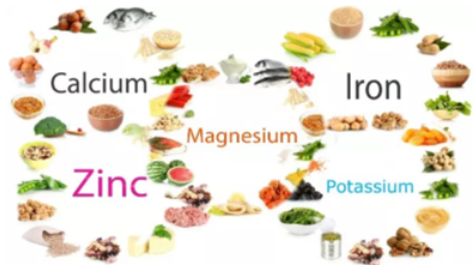
Fig.3: The five major minerals and their source foods
- Dietary Fibers/Roughage: While dietary fibers do not provide any such nutrition to our bodies but nevertheless are an important component of food. They help in easy absorption of food, helps in movement of bowel and prevents constipation. It helps our body get rid of undigested food. Cereals, fruits and vegetables are some of the roughage rich foods.
- Water: Water performs the essential function of absorbing nutrients from our food. It also helps in releasing waste from our body in form of sweat and urine.
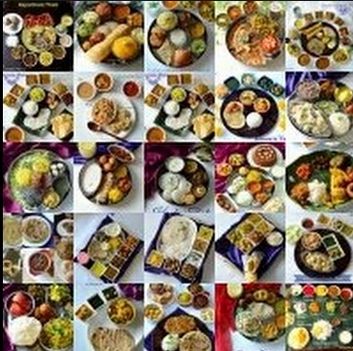
- Our food contains mainly five major kinds of nutrients namely vitamins, minerals, carbohydrates, proteins and fats. Additionally, food also contains water and dietary fibres/roughage and water which are also required by our bodies.
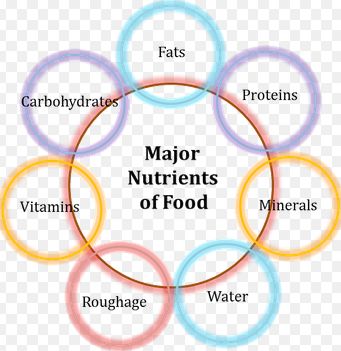
Fig. 1: Major nutrients of food
Carbohydrates: Carbohydrates main function is providing energy to the body. These are found in our food in the form of sugar and starch i.e. simple and complex carbohydrates. Example It is found in bread, potatoes etc.
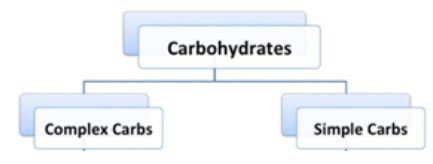
Fig.2: The Two Types of Carbohydrate
Simple Carbohydrates: These are also referred to as simple sugars, containing single monosaccharide units and found in natural sources of food i.e. milk, fruits and vegetables. These carbohydrates add certain sweetness to the food. They raise the level of blood glucose quickly but are easier to break down.
Complex Carbohydrates: These are also referred to as polysaccharides, meaning they contain hundreds or thousands of such monosaccharide units. These are typically found in wheat grain, white bread, kernel and cakes. They are relatively less sweet than simple carbohydrates and also raise blood glucose level rather slowly. However, these are tougher to break down. Cellulose is present in plant cell wall. It is a complex carbohydrate. Humans cannot digest cellulose.
Test for carbohydrates: We can test whether a particular food item contains carbohydrates by pouring 2 to 3 drops of dilute iodine solution on it. If the iodine changes its colour to blue-black, then we can ascertain that the food item does, in fact, contain carbohydrates.
Proteins: Proteins performs the very essential function of helping our body grow and repair itself. These are found in food items such as milk, pulses, eggs, meat etc. Foods containing proteins are called ‘body-building’ foods.
Test for proteins: To test whether a food item contains proteins, first we need to grind it into a paste or powder form and add 10 drops of water. To this mixture when we add 2 drops of copper sulphate solution and 10 drops of caustic soda solution. After a few minutes, if the mixture turns violet, it is indicative of the presence of protein.
Fats: Fats are also responsible for providing energy to our body. In fact, they provide more energy than carbohydrates. The body uses fat as a fuel source. Fats are essential for the absorption of vitamins A, D, E and K in the body. Butter, cheese, oil are all examples of fat-rich foods.
Test for fats: To test for fats, take a small quantity of food item and wrap a piece of paper around it and proceed to crush it. After removing the paper, allow it to dry. If you see a film of an oily patch on the paper when holding it against light, it is proof that the food contains fats.
Vitamins: Vitamins help in protecting our bodies from various kinds of diseases. They also help in keeping our eyes, gums, bones and teeth in good shape. Different types of vitamins and their uses:
Minerals: Minerals are used by the body to perform various functions like building strong bones, maintaining the heartbeat, making hormones etc. The major five minerals are Calcium, Phosphorus, Magnesium, Sodium and Potassium. Examples of mineral-rich foods include leafy vegetables, fish, beans etc.
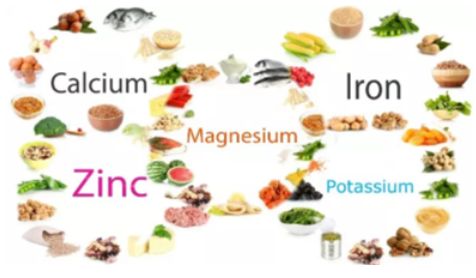
Fig.3: The five major minerals and their source foods
Dietary Fibers/Roughage: While dietary fibers do not provide any such nutrition to our bodies but nevertheless are an important component of food. They help in easy absorption of food, helps in movement of bowel and prevents constipation. It helps our body get rid of undigested food. Cereals, fruits and vegetables are some of the roughage rich foods.
Water: Water performs the essential function of absorbing nutrients from our food. It also helps in releasing waste from our body in form of sweat and urine
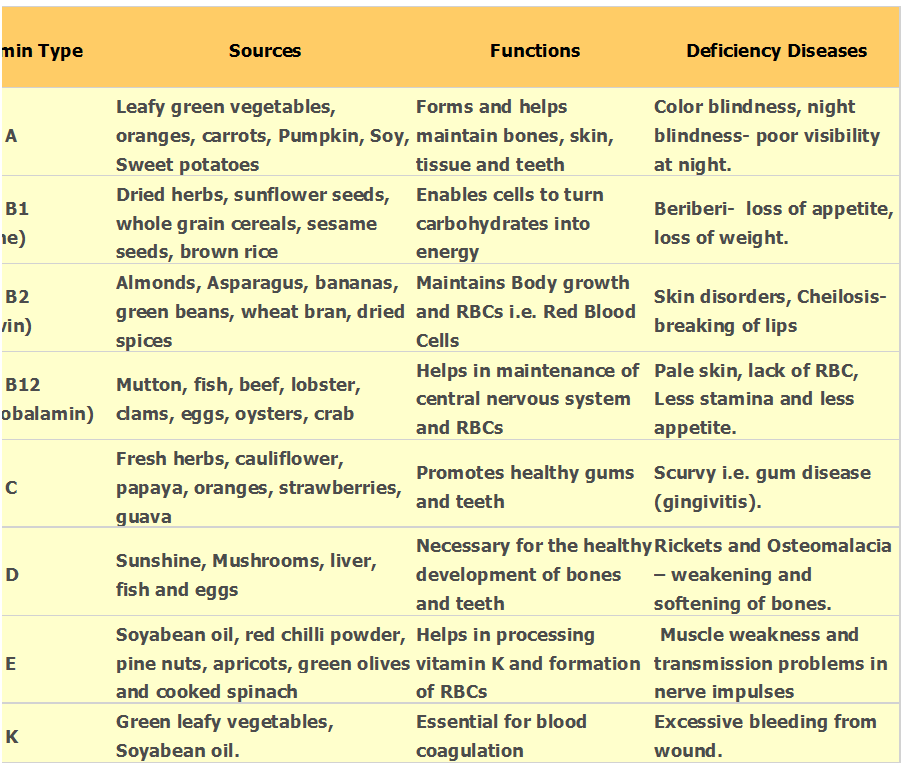
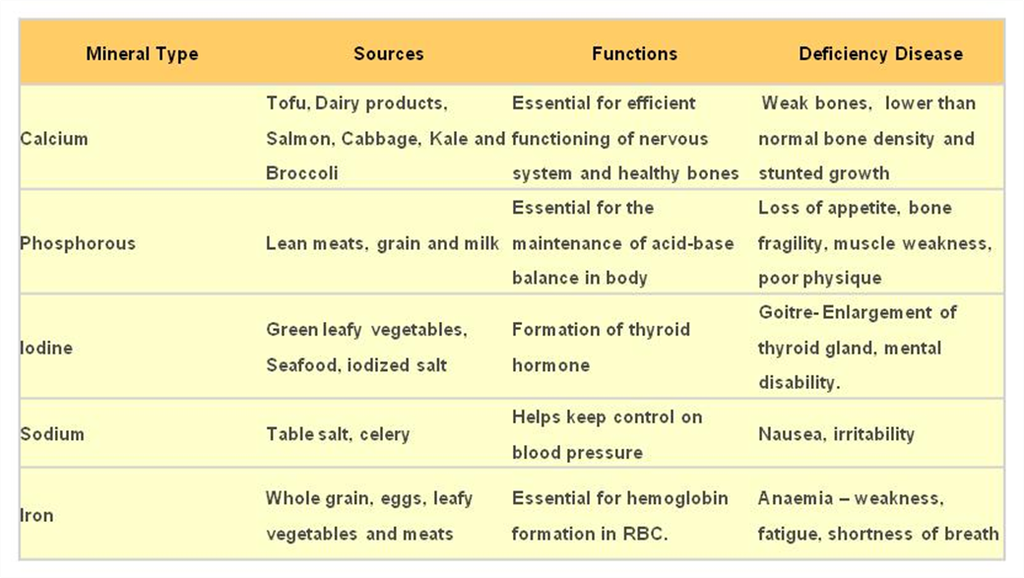
Summary
Carbohydrates and Fats
Carbohydrates in our food are mainly sugar, starch.
Starch is present in grains like rice, wheat, maize, tubers like potatoes etc.
Sugar is the sweet substance. Common sugar we use is Sucrose and it is obtained from Sugar cane
Fats are stored energy resource. Animal sources include milk, butter, ghee, cheese and meat and Plants resources like oil are rich resources of fats
Proteins
Proteins are body-building food as they help in body growth and repair of damaged parts of the body.
Animal sources like eggs, fish, meat, milk, cheese and Plant sources like pulses of beans are resource of proteins
Proteins are broken-down by the digestive system into amino acids (which can be absorbed into the blood).
Vitamins and Minerals
Vitamins are protective food as they protect us from many diseases. They give us resistance against disease causing germ
Vitamins are A, B, C.D, K, E. They are obtained from Fruits, vegetables, fish liver oil, milk, eggs,
Minerals are also required in small quantities. Minerals include sodium, Calcium, Potassium, iodine and phosphorous

 Param Publication
Param Publication
 PathSet Publications
PathSet Publications
